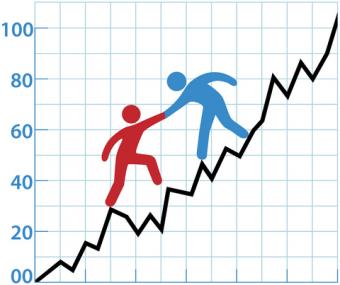Without mentoring, girls lose interest in STEM fields
 Stoeger, H., Duan, X., Schimer, S., Greindl, T., & Ziegler, A. (2013). The effectiveness of a one-year online mentoring program for girls in STEM. Computers & Education, 69, 408-418.
Stoeger, H., Duan, X., Schimer, S., Greindl, T., & Ziegler, A. (2013). The effectiveness of a one-year online mentoring program for girls in STEM. Computers & Education, 69, 408-418.
Summarized by Jessica Cunningham, B.A. Lab Manager, Center of Evidence-Based Mentoring
Introduction:
As you may have already heard, women are highly under-represented in the fields of Science, Technology, Engineering, and Mathematics (abbreviated as STEM). It is often the case that young girls and women are interested in STEM fields, but that their performance and interests in these subjects drops as they age, which could be the result of a number of factors, including societal attitudes that women aren’t good at STEM subjects, fears related to being “the only” woman in a particular job setting, or just changing interests. In terms of career options, STEM fields are one of the fastest growing and highest paid sectors, so any youth with the aptitude and interest in it should be encouraged to pursue these fields. One way to help youth to explore their career options and interests is through matching them with someone working in the field itself, which was exactly the purpose of the CyberMentor program in Germany. It was designed to help girls maintain their interest in STEM fields by matching them with a female mentor who worked in a STEM field they were interested in; having a mentor actually helped to prevent the loss of interest in STEM fields.
Background:
Although the performance of women and girls in STEM is improving, their interest in STEM fields which are still much lower than that of men and boys’. Thus, many initiatives to encourage girls and women to pursue STEM fields for careers have developed. The authors cite concerns that the lack of women pursuing STEM fields at a university will result in detriment to women as individuals (i.e. lower rates of pay, less control over job prospects, etc.) as well as to the country, represented as chronic shortages of people in fields like medicine or computer sciences. Role modeling through mentoring may be an effective means of encouraging girls to pursue these studies.
Previous research has shown that mentoring can be a very effective way to help youth to improve their grades, but effect sizes are often small in these studies. Mentoring organizations are also plagued with a multitude of issues, for example, geographical distance, scheduling conflicts, or shortages of qualified mentors in a particular region, which can lead to fewer meetings between pairs and youth waiting for a significant period of time to be matched. Mentoring via the internet can solve many of these problems, but investigating the efficacy and any potential trade-offs of e-mentoring are still a burgeoning field.
The researchers of this study wanted to investigate the efficacy of an e-mentoring program designed to encourage girls to pursue STEM-related studies.
Method:
CyberMentor is open to female students in Germany from the age of 11 (identified by previous research to be the age when girls start losing interest in STEM) to 18. Students are assigned a personal female mentor who is either a college student pursuing a STEM major, or a professional working in a STEM field and are matched by mutual interests.
Mentors are trained and offered match support by program coordinators. Participants agree to exchange emails once per week on STEM topics and use forums open to all matches as often as possible.
Since the participants’ college decisions will potentially be made years after the program begins, the immediate goals of CyberMentor are to increase girls’ interest in STEM activities, increase mentee’s knowledge about STEM topics and career options in the field, and to increase confidence in one’s own STEM abilities.
One thousand fifty-four girls applied for the CyberMentor program; 800 were selected for participation, and the remaining 254 were put on a wait-list control group. The average age of mentees was 13.51 years, and 312 of the applicants filled out the voluntary questionnaire distributed as part of the study. Two hundred eight of these respondents were in the treatment group, and 104 were in the control group. Data were collected at three time points; before the study began, in the middle of the first year, and at the end of the first year.
The researchers developed scales to assess change on domains related to STEM in the mentees. To measure the change in STEM activities, they asked six questions such as “Have you ever…read a book on a subject in STEM; discussed a STEM topic with your friends?” The researchers assessed mentee’s knowledge on STEM topics by asking “how much do you know about STEM?” and asking girls to rate themselves on a 5 point scale from “a little” to “a lot”. The researchers assessed mentees’ knowledge about university studies and jobs in STEM by asking them to rate their knowledge in the same format as above. The authors measured girls’ interest in STEM domains by asking them to rate their interest in the same format as above. Confidence in one’s own STEM abilities was measured using a modified version of Dweck’s “belief in one’s own abilities” scale, which is a four-item scale that asks participants to rate how closely they align with two polarized statements such as: “I do not have a great deal of confidence in my STEM abilities versus I have a great deal of confidence in my STEM abilities.” Self-assessment of STEM competencies was measured by asking students “How good are you in STEM?” and asking them to rate themselves in the same researcher-made format. Academic elective intentions were measured by asking participants how well they could picture themselves choosing a university major in STEM, a STEM subject for a subject at school, and pursuing a career in a STEM field.
Results:
The researchers found that the mentored girls reported significantly higher levels of STEM activities, self-assessment of STEM knowledge, self-assessment about university studies and jobs in STEM, confidence in STEM abilities, self-assessment of STEM competencies than their control group counterparts. Mentored youth were also more likely to have STEM-related academic intentions.
Discussion and Conclusions:
Since the researchers used a control group with comparable STEM interests, and measured changes over three-time points, the pitfalls of other mentoring studies have been avoided, because the control group is actually similar to the treatment group, and by measuring effects over time, the researchers avoid simply observing novelty effects.
E-mentoring allows pairs the flexibility in scheduling that is often difficult to achieve in offline mentoring, along with not being limited by geographic locations. E-mentoring allows for higher frequencies of contact, which have been shown to be connected to match success, and gives people access to appropriate role models for their field of interest.
The researchers were particularly excited to note that “the values [in STEM measures] in the treatment group remained roughly the same, over the course of the mentoring year, while the waiting-list control group showed a decrease,” because it shows that mentoring has a preventative effect on losing interest in STEM fields. Without mentoring, girls lost interest in STEM. They note that the effect sizes are small, but similar to those in offline mentoring programs, and that small effect sizes do not always equate to small impact; small gains for girls in STEM may have a huge impact on their lives.
The authors close with the thought that “the increase in STEM activities is worth noting because studies show that even when female school students do have high levels of interest in STEM, their environments nevertheless usually fail to offer them better encouragement options than do the environments of girls without particular STEM interests.” This program has provided these girls with the scaffolding they need to continue to pursue their interests in a greater capacity than they were before they started the program.














